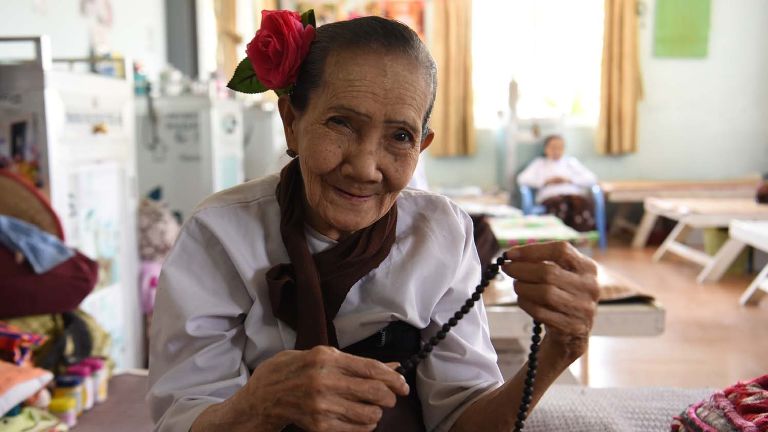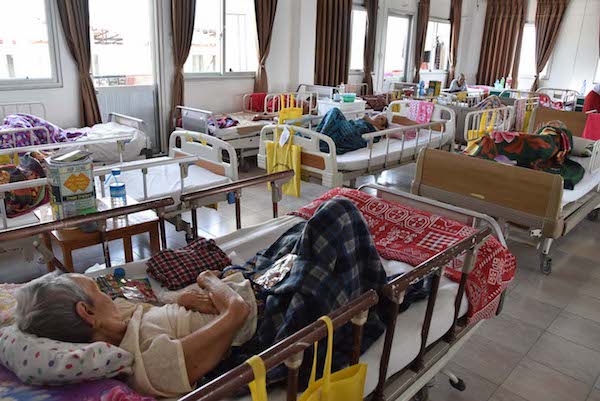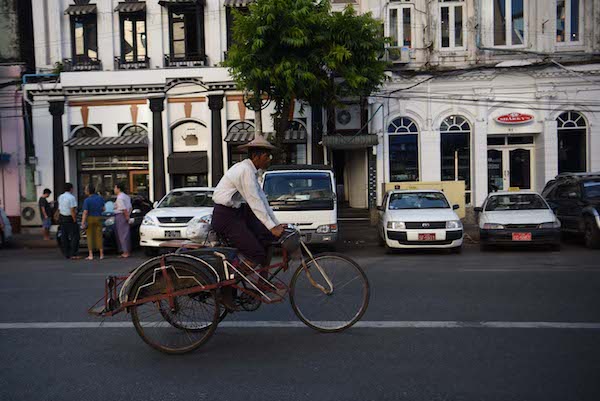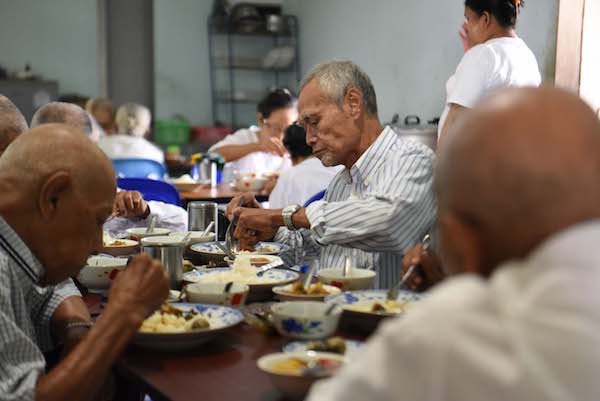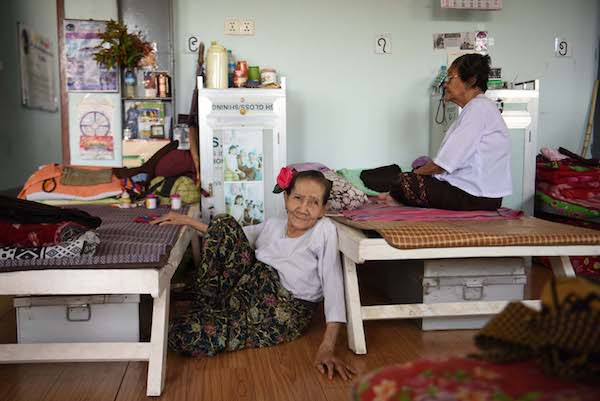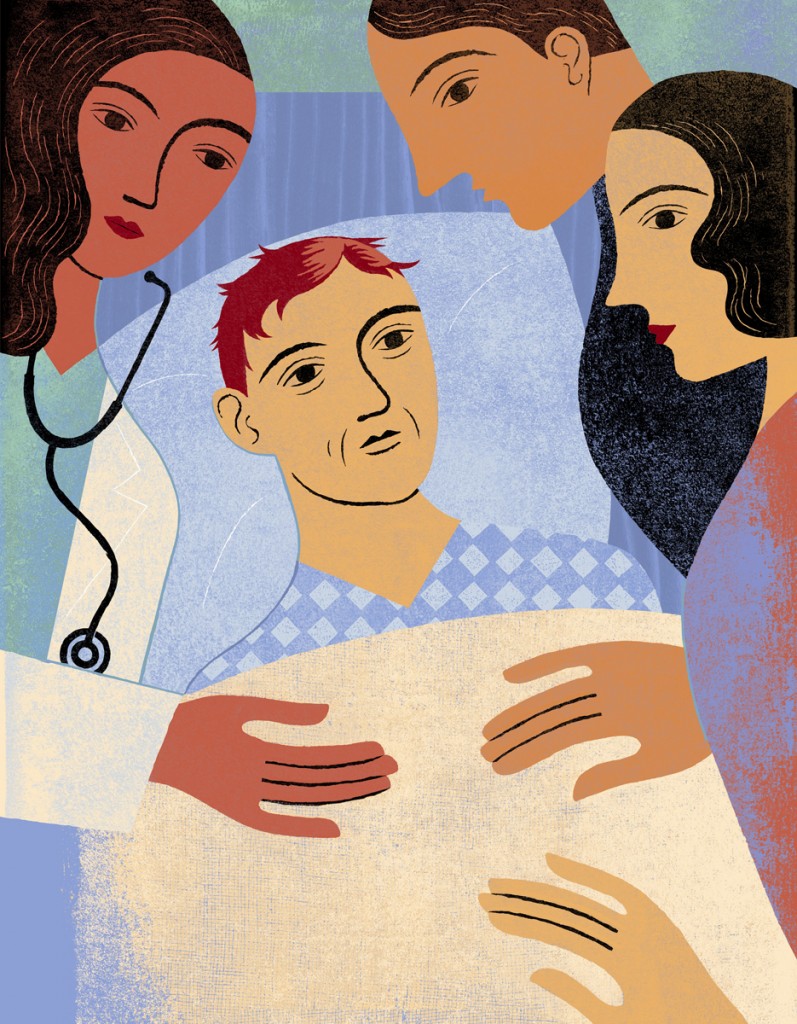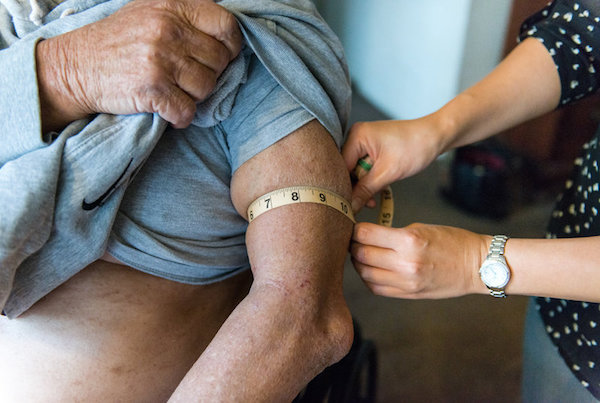
By Anna Gorman
[G]erald Chinchar, a Navy veteran who loves TV Westerns, isn’t quite at the end of his life, but the end is probably not far away. The 77-year-old’s medications fill a dresser drawer, and congestive heart failure puts him at high risk of emergency room visits and long hospital stays. He fell twice last year, shattering his hip and femur, and now gets around his San Diego home in a wheelchair.
Above all, Chinchar hopes to avoid another long stint in the hospital. He still likes to go watch his grandchildren’s sporting events and play blackjack at the casino.
“If they told me I had six months to live, or [could instead] go to the hospital and last two years, I’d say leave me home,” he said. “That ain’t no trade for me.”
Most aging people would choose to stay home in their last years of life. But for many, it doesn’t work out: They go in and out of hospitals, getting treated for flare-ups of various chronic illnesses. It’s a massive problem that costs the health care system billions of dollars and has galvanized health providers, hospital administrators and policymakers to search for solutions.
Sharp HealthCare, the San Diego health system where Chinchar receives care, has devised a way to fulfill his wishes and reduce costs at the same time. It’s a pre-hospice program called Transitions, designed to give elderly patients the care they want at home and keep them out of the hospital.
Social workers and nurses from Sharp regularly visit patients in their homes to explain what they can expect in their final years, help them make end-of-life plans and teach them how to better manage their diseases. Physicians track their health and scrap unnecessary medications.
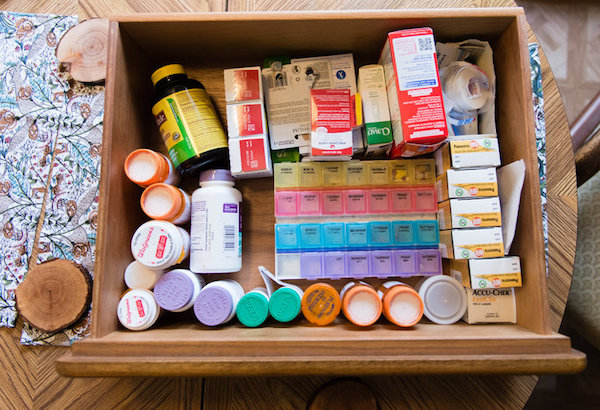
Unlike hospice care, patients in this program don’t need to have a prognosis of six months or less to live, and they can continue getting treatment that is aimed at curing their illnesses, not just treating symptoms.
Before the Transitions program started, the only option for many patients in a health crisis was to call 911 and be rushed to the emergency room. Now, they can get round-the-clock access to nurses, one phone call away.
“Transitions is for just that point where people are starting to realize they can see the end of the road,” said Dr. Dan Hoefer, a San Diego palliative care and family practice physician, and one of the creators of the program. “We are trying to help them through that process,” he said, “so it’s not filled with chaos.”
The importance of programs like Transitions is likely to grow in coming years as 10,000 baby boomers — many with multiple chronic diseases — turn 65 every day. Transitions was among the first of its kind, but several such programs, formally known as home-based palliative care, have since opened around the country. They are part of a broader push to improve people’s health and reduce spending through better coordination of care and more treatment outside hospital walls.
But a huge barrier stands in the way of pre-hospice programs: There is no clear way to pay for them. Health providers typically get paid for office visits and procedures, and hospitals still get reimbursed for patients in their beds. The services provided by home-based palliative care don’t fit that model.
In recent years, however, pressure has mounted to continue moving away from traditional payment systems. The Affordable Care Act has established new rules and pilot programs that reward the quality of care, rather than the quantity. Those changes are helping to make home-based palliative care a more viable option.
In San Diego, Sharp’s palliative care program has a strong incentive to reduce the cost of caring for its patients, who are all in Medicare managed care. The nonprofit health organization receives a fixed amount of money per member each month, so it can pocket what it doesn’t spend on hospital stays and other costly medical interventions.
‘Something that works’
Palliative care focuses on relieving patients’ stress, pain and other symptoms as their health declines, and it helps them maintain their quality of life. It’s for people with serious illnesses, such as cancer, dementia and heart failure. The idea is for patients to get palliative care and then move into hospice care, but they don’t always make that transition.
The 2014 report “Dying in America,” by the Institute of Medicine, recommended that all people with serious advanced illness have access to palliative care. Many hospitals now have palliative care programs, delivered by teams of social workers, chaplains, doctors and nurses, for patients who aren’t yet ready for hospice. But until recently, few such efforts had opened beyond the confines of hospitals.
Kaiser Permanente set out to address this gap nearly 20 years ago, creating a home-based palliative care program that it tested in California and later in Hawaii and Colorado. Two studies by Kaiser and others found that participants were far more likely to be satisfied with their care and more likely to die at home than those not in the program. (Kaiser Health News is not affiliated with Kaiser Permanente.)
One of the studies, published in 2007, found that 36 percent of people receiving palliative care at home were hospitalized in their final months, compared with 59 percent of those getting standard care. The overall cost of care for those who participated in the program was a third less than for those who didn’t.
“We thought, ‘Wow. We have something that works,'” said Susan Enguidanos, an associate professor of gerontology at the University of Southern California’s Leonard Davis School of Gerontology, who worked on both studies. “Immediately we wanted to go and change the world.”
But Enguidanos knew that Kaiser Permanente was unlike most health organizations. It was responsible for both insuring and treating its patients, so it had a clear financial motivation to improve care and control costs. Enguidanos said she talked to medical providers around the nation about this type of palliative care, but the concept didn’t take off at the time. Providers kept asking the same question: How do you pay for it without charging patients or insurers?
“I liken it to paddling out too soon for the wave,” she said. “We were out there too soon. … But we didn’t have the right environment, the right incentive.”
A bold idea, rooted in experience
Hoefer is a former hospice and home health medical director and has spent years treating elderly patients. He learned an important lesson when seeing patients in his office: Despite the medical care they received, “they were far more likely to be admitted to the hospital than make it back to see me.”

Doctors, nurses and social workers meet bimonthly to discuss patient cases for the Sharp HealthCare Transitions program in San Diego.
When his patients were hospitalized, many would decline quickly. Even if their immediate symptoms were treated successfully, they would sometimes leave the hospital less able to take care of themselves. They would get infections or suffer from delirium. Some would fall.
Hoefer’s colleague, Suzi Johnson, a nurse and administrator in Sharp’s hospice program, saw the opposite side of the equation. Patients admitted into hospice care would make surprising turnarounds once they stopped going to the hospital and started getting medical and social support at home, instead. Some lived longer than doctors had expected.
In 2005, the pair hatched a bold idea: What if they could design a home-based program for patients before they were eligible for hospice? Thus, Transitions was born. They modeled their new program in part on the Kaiser experiment, then set out to persuade doctors, medical directors and financial officers to try it. But they met resistance from physicians and hospital administrators who were used to getting paid for seeing patients.
“We were doing something that was really revolutionary, that really went against the culture of health care at the time,” Johnson said. “We were inspired by the broken system and the opportunity we saw to fix something.”
Despite the concerns, Sharp’s foundation board gave the pair a $180,000 grant to test out Transitions. And in 2007, they started with heart failure patients and later expanded the program to those with advanced cancer, dementia, chronic obstructive pulmonary disease and other progressive illnesses. They started to win over some doctors who appreciated having additional eyes on their patients, but they still encountered “some skepticism about whether it was really going to do any good for our patients,” said Dr. Jeremy Hogan, a neurologist with Sharp. “It wasn’t really clear to the group … what the purpose of providing a service like this was.”
Nevertheless, Hogan referred some of his dementia patients to the program and quickly realized that the extra support for them and their families meant fewer panicked calls and emergency room trips.
Hoefer said doctors started realizing home-based care made sense for these patients — many of whom were too frail to get to a doctor’s office regularly. “At this point in the patient’s life, we should be bringing health care to the patient, not the other way around,” he said.
Across the country, more doctors, hospitals and insurers are starting to see the value of home-based palliative care, said Kathleen Kerr, a health care consultant who researches palliative care.
“It is picking up steam,” she said. “You know you are going to take better care of this population, and you are absolutely going to have lower health care costs.”

Providers are motivated in part by a growing body of research. Two studies of Transitions in 2013 and 2016 reaffirmed that such programs save money. The second study, led by outside evaluators, showed it saved more than $4,200 per month on cancer patients and nearly $3,500 on those with heart failure.
The biggest differences occurred in the final two months of life, said one of the researchers, Brian Cassel, who is palliative care research director at the Virginia Commonwealth University School of Medicine in Richmond.
A home visit tailored to each family
Nurse Sheri Juan and social worker Mike Velasco, who both work for Sharp, walked up a wooden ramp to the Chinchars’ front door one recent January morning. Juan rolled a small suitcase behind her containing a blood pressure cuff, a stethoscope, books, a laptop computer and a printer.

Late last year, Gerald Chinchar’s doctor recommended he enroll in Transitions, explaining that his health was in a “tenuous position.” Chinchar has nine grandchildren and four great-grandchildren. He has had breathing problems much of his life, suffering from asthma and chronic obstructive pulmonary disease — ailments he partly attributes to the four decades he spent painting and sandblasting fuel tanks for work. Chinchar also recently learned he had heart failure.
“I never knew I had any heart trouble,” he said. “That was the only good thing I had going for me.”
Gerald Chinchar’s wife, Mary Jo (right), told the visiting nurse she especially appreciates getting the advice about what her husband should eat and drink. He doesn’t always listen to his wife, Mary Jo said. “It’s better to come from somebody else.”
Now he’s trying to figure out how to keep it from getting worse: How much should he drink? What is he supposed to eat?
That’s where Juan comes in. Her job is to make sure the Chinchars understand Gerald’s disease so he doesn’t have a flare-up that could send him to the emergency room. She sat beside the couple in their living room and asked a series of questions: Any pain today? How is your breathing?
Juan checked his blood pressure and examined his feet and legs for signs of more swelling. She looked through his medications and told him which ones the doctor wanted him to stop taking.
“What we like to do as a palliative care program is streamline your medication list,” she told him. “They may be doing more harm than good.”
His wife, Mary Jo Chinchar, said she appreciates the visits, especially the advice about what Gerald should eat and drink. Her husband doesn’t always listen to her, she said. “It’s better to come from somebody else.”
Growing acceptance of palliative care

Outpatient palliative care programs are cropping up in various forms. Some new ones are run by insurers, others by health systems or hospice organizations. Others are for-profit, including Aspire Health, which was started by former senator Bill Frist in 2013.
Sutter Health operates a project called Advanced Illness Management to help patients manage symptoms and medications and plan for the future. The University of Southern California and Blue Shield of California recently received a $5 million grant to provide and study outpatient care. “The climate has changed for palliative care,” said Enguidanos, the lead investigator on the USC-Blue Shield project.
Ritchie said she expects even more home-based programs in the years to come. “My expectation is that much of what is being done in the hospital won’t need to be done in the hospital anymore and it can be done in people’s homes,” she said.
Challenges remain, however. Some doctors are unfamiliar with the approach, and patients may be reluctant, especially those who haven’t clearly been told they have a terminal diagnosis. Now, some palliative care providers and researchers worry about the impact of President Donald Trump’s plans to repeal the Affordable Care Act and revamp Medicare — efforts that seem to be back in play.
Gerald Chinchar, who grew up in Connecticut, said he never expected to live into old age. In his family, Chinchar said, “you’re an old-timer if you make 60.”
Chinchar said he gave up drinking and is trying to eat less of his favorite foods — steak sandwiches and fish and chips. He just turned 77, a milestone he credits partly to the pre-hospice program.
“If I make 80, I figured I did pretty good,” he said. “And if I make 80, I’ll shoot for 85.”
Complete Article HERE!
For old folks left to die at Myanmar’s roadsides and cemeteries, these homes are their last hope
Cast aside “like rubbish” and turned away even by nursing homes, these elderly outcasts are given dignity at the end of life by volunteer groups outraged by their plight.
By
YANGON, MYANMAR: There she lay, on the ground in the darkness of night, moaning in pain as rats – drawn to the smell of blood from the lacerations on her body – nibbled at her wounds.
The elderly woman had just been involved in a road accident. But instead of getting help, the driver had abandoned the woman next to a rubbish dump by the road to fend for herself.
Daw Khin Ma Ma said her stomach churned at the sight of the battered old woman who was eventually conveyed to her nursing home. “Her rib bones were broken, some of which had pierced her lungs. We could see a hole in her back that had been gnawed on by the rats,” she said.
“I’ve never seen such a terrible case before.”
The woman died some six months after arriving at the home.
Daw Khin is the vice-president of Twilight Villa (See Sar Yeik), a nursing home in Myanmar which takes in abandoned sick elderly citizens whom other homes turn away. This horrifying episode is just one example of why she is so dedicated to helping this group.
Cases of seniors being left abandoned by families near markets, railway stations and even cemeteries are on the rise. “These grandpas and grandmas at our nursing home have been cast aside at hospitals and under bridges like rubbish,” she said with heat.
(LINK: Poverty forces families in Myanmar to ditch their elderly)
Twilight Villa is tucked in a quiet corner surrounded by thatch and bamboo houses, an hour’s drive from downtown Yangon.
It started out with just eight senior citizens housed in a one-storey building in 2010, but today, it operates out of a modern four-storey building that includes an intensive care floor, courtesy of generous donors.
The home currently has capacity for about 70 people, but there are 50 more on the waiting list. It takes in only those over 70 years of age who are ailing and without any traceable family.
FAMILIES GO TO LENGTHS TO DUMP THEIR ELDERLY
Daw Khin is among a small but growing number of individuals and local non-profit organisations that have stepped forward to help the sick elderly who are in the last years or even months of life.
They have no training in nursing nor geriatrics, driven only by their passion to provide this group with dignified end-of-life care.
Daw Khin, a criminal lawyer by profession, co-founded Twilight Villa along with local philanthropist and award-winning writer Daw Than Myint Aung in 2010, after they found that nursing homes were unwilling to accept the sick elderly.
She said that some of these seniors are referred to them by the police, and they have little memory of their identities.
“Sometimes in the pocket of their jacket, there would be a note with just their name and age, such as Daw Pu, age 80. That’s all. When we ask them more, they can’t remember anything else,” she said.
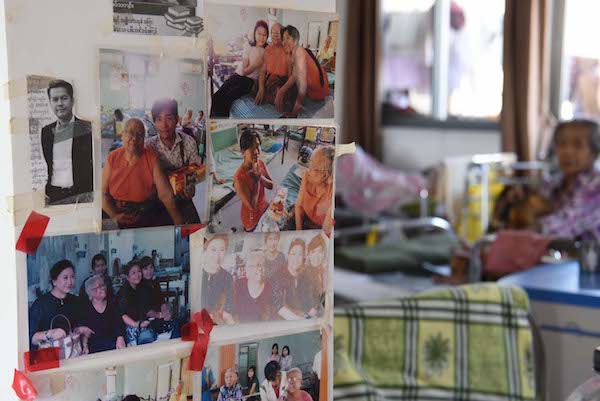
Daw Khin fumed at how some caregivers go to great lengths to abandon these seniors – even using different modes of transport to ensure that they can’t find their way home.
“They might be transported in a car, then a trishaw, and then by ferry to the other side of the river where they’re abandoned,” she said.
Some are dumped because they had suffered a stroke or some mental illness. “When we ask them where they live, they would say, ‘a market is near my house, and I have little grandchildren’. If they could remember more details, we would surely send them back,” she said.
Then there are those like 87-year-old Daw Kyi Kyi, who was referred to the home after her husband and two sisters died. She has no children.
She wakes at 5am every day and spends her time praying and meditating. The company of friends and the staff at the home help to relieve any loneliness. “I am happy here,” she said. “I can live peacefully; it’s like living in heaven with all my friends.”
TURNING TO SOCIAL MEDIA TO RALLY HELP
Like Twilight Villa, the group Save The Aged focuses on the sick elderly who have nowhere else to go.
It was started by a group of 15 young, public-spirited volunteers who were so moved by their plight, they took to the Internet and social media to rally help for them.
So successful were they that – for a country with a low Internet penetration rate – they managed to raise enough funds solely through social media to open a nursing home in 2015.
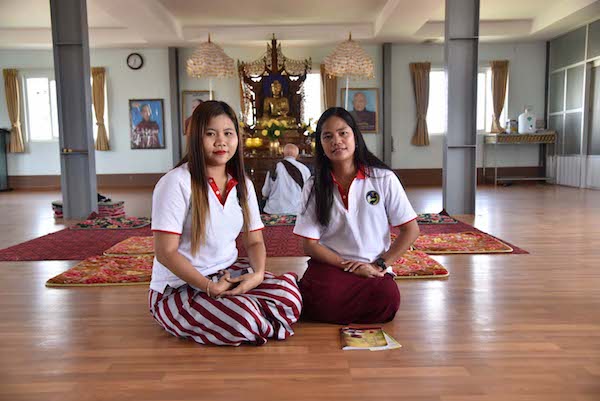
Volunteer and accountant Daw Phyo Thiri said: “There were other organisations such as Save the Children but there were none that looked after the elderly. We were inspired to create a group to help those that we had met.”
They started out by repairing the homes of these old folks and helping them with expenses such as for food and medicine, as well as conveying them to the hospital when they were sick. They had no donors initially, and most of their expenses were borne by the volunteers.
With no physical office, they communicated via WhatsApp and social media, posting pictures and videos of their activities on Facebook. As their digital presence grew, they managed to get donations and more volunteers, especially among the young.
Save the Aged currently provides care and accommodation to around 25 homeless elderly, all aged above 65.
Resident Daw Kyi Kyi Khin, 85, was living alone and surviving on occasional donations when some Save The Aged volunteers brought her to the home.
She said: “Now I live peacefully here and I have nothing to worry about. They treat us like their own parents or grandparents.”
NO MONEY TO DO MORE
However, funding continues to be an issue for these NGOs – a problem made even more acute in a poor country like Myanmar.
Daw Phyo said Save The Aged would like to do more but is limited by the lack of resources. The NGO relies solely on donors, who include Myanmar nationals overseas in countries such as Singapore, South Korea and Australia.
When they were building the home, they had to pay for the construction in instalments – and at one stage, they ran out of funds. Thankfully, another appeal for funds online managed to raise enough to complete the project.
“We only have enough funds to run the day-to-day operations,” said Daw Phyo. “For the longer term, we would like to expand, to buy new land and build new homes. We would like to support the elderly even more, and we are looking for donors.”
Twilight Villa, too, relies mostly on public donations.
The government’s Social Welfare Department provides the organisation with 25,000,000 kyats (S$26,000) a year in subsidies but they can only use it to buy rice.
Daw Khin said she would prefer to have more flexibility with the subsidy, for medical supplies or to pay their employees.
AN AGED HOME WITHOUT ELDERLY?
But more than that, she would love to see the day when there is no more need for homes such as hers.
She cited the example of one home for the aged she knows of which – curiously enough – has no seniors living there.
The residents in that village in the state of Kachin have learnt to value and respect their elderly folks for the part they have played in society, and so everyone chips in to take care of them in their twilight years, she said.
“If a family is too poor to take care of an elderly person, they will bring that person to another family who will take care of him or her. The whole village takes care of the elderly. That’s why there is no old person in the home for the aged.
“This is excellent. We need this to be the situation in every family,” she said.
Complete Article HERE!
How to Live When You’re Dying
Embrace the idea of death for a better life.
By Wesley Baines
Death.
It’s a concept that few wish to dwell on, but one that will eventually become a reality for each of us. For some of us, it comes rushing up sooner than we’d like, and suddenly the hands of the clock are moved up to five minutes till midnight. For others, the hands move at their normal pace, but our minds linger on what those final moments will hold.
The truth is that we are all dying. Every last one of us. But by learning to accept death, by allowing the ticking clock to drive us to greater heights rather than to deeper despair, we can truly live. And in choosing to live in the face of death, we not only improve the time we have left, but also set an example for others so that they might do the same.
Whether you’ve recently found your own clock unexpectedly moved forward or if you simply find your eventual end more discomforting than you’d like, there are lessons to learn here that will make the remainder of your life not mere a series of days, but beautifully alive.
Accept and Acknowledge
As a culture, we don’t like to talk about death—it’s one of our staunchest taboos. But the problem with this is that we don’t deal with it. We pretend it doesn’t exist, that the clock isn’t ticking at all.
And so because we don’t deal with death in a meaningful way, we become divided into two camps—those who are paralyzed by the fear of death, and those who feel it will never happen to them. Both views are mistakes.
Those who are terrified of death are limited by it. They are confined to what is safe, and live lives of mental agony. Those who feel invincible, on the other hand, lack the motivation that only an awareness of our limited time can bring.
But when we embrace death, when we acknowledge it by openly talking about it, and when we can accept that it is inevitable, we can make use of it. It can be our friend.
When Steve Jobs gave his 2005 Stanford commencement speech, he told the students: “No one wants to die. Even people who want to go to heaven don’t want to die to get there. And yet death is the destination we all share. No one has ever escaped it. And that is as it should be, because Death is very likely the single best invention of Life. It is Life’s change agent.”
He went on, saying “Remembering that you are going to die is the best way I know to avoid the trap of thinking you have something to lose. You are already naked. There is no reason not to follow your heart.”
Dealing with your own impermanence is painful. It means making yourself vulnerable and open. It means intentionally processing things you’d rather tuck beneath the rug. But when you do, when you accept and acknowledge, you can move past the fear of, or indifference toward, death, and in doing so, you may just find life for the first time.
Be Kind to Yourself
Learning how to live in the face of death means learning to love yourself. It means you learning to be kind to you.
This means several things. First, it means, as Jobs said, avoiding the idea that you have something to lose—forgive yourself for any perceived failures. The burdens you place upon yourself, the weights you pile onto your shoulders—take them off. They’re not a big deal.
This doesn’t mean shirking your responsibilities toward those you love and care about. It doesn’t mean that you don’t work to make the world a better place. This simply means that you don’t carry these things as a weight. You don’t constantly berate yourself for not attending to them well enough.
You do your best and move on.
If you have a habit of being unkind to yourself, tapping into the awareness of death is an empowering tool that can help you forgive yourself. And once you forgive yourself and let go of your fears of imperfection and underachievement, you’ll have so much more room in your life for the things that truly matter.
Perspective and Priorities
Considering the reality of death brings perspective. It helps us see what is truly important.
What matters to you? Is it your family? Is it your web of relationships? Are you committed to a cause? Are you bent on creating something beautiful with your life? Are you spiritual or religious? What deserves your time?
Likewise, what are you doing that is wasting your time—for many, the thought of death brings this to mind first. Are you working overly long hours or spending time with people who don’t truly value you? Are you obsessed with the future at the cost of living in the moment?
Once you’ve acknowledged death as a part of life, you can use this to drive you trim the fat and focus on what’s really important to you. It forces you to examine your life, and like Socrates once suggested, the examined life is the one worth living.
In an interview with the Guardian, Holly Webber, a British woman diagnosed with terminal cancer, has this to say about how her perspective has changed since her diagnosis.
“Sometimes I feel like I’m on another planet looking in on this one. I can’t relate to people stressing about work or getting the Tube. People are so wound up, but it’s such a waste of time and energy. Chill out! I hope that by reading this, someone out there will take a second to think, ‘I’m glad that’s not me. Maybe I should worry less about the things that don’t really matter.’”
Allow death to grant you perspective on your priorities, and you’ll gain the life you truly want.
A New Life From Death
You’ve heard the old cliché, “Carpe diem,” which is Latin for “Seize the day”. This phrase is the essence of what death has to teach us. Be present. Live in the moment. Love the people in your life with all your heart and mind and soul.
Because in a hundred years, those business reports will be dust. Your money will be gone. Your fears and burdens won’t matter.
And that should make you feel free, not fearful.
So be open to the idea of death. Talk about it without fear or denial. Use it to shed your woes and gain a better perspective on your priorities.
Above all, use death to live. It’s one of the best things you can do for yourself, as well as for those who love you.
Complete Article HERE!
At the End of Life, a Way to Go Gentle
By
[W]hile confronting the prospect of death, people like me — grappling with a diagnosis of advanced cancer — often consider what sort of care they want and how to say goodbye. Given the delicate negotiations in which the dying need to engage, do intensive care physicians with their draconian interventions act like proverbial bulls in a china shop? My fear of pointless end-of-life treatments, performed while I was in no condition to reject them, escalated when I read Dr. Jessica Nutik Zitter’s book, “Extreme Measures: Finding a Better Path to the End of Life.”
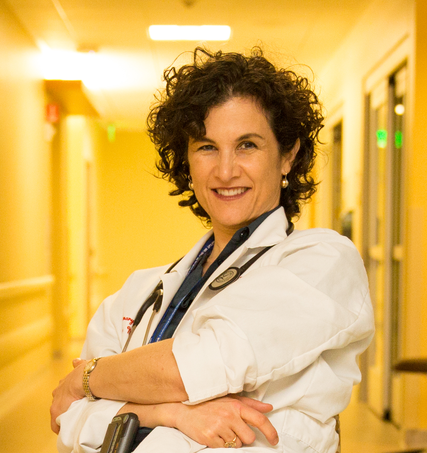
Dr. Zitter confronts the sort of scenario that haunts me because she works in specialties that are sometimes seen as contradictory: pulmonary/critical care and palliative care.
In her new book, she refers to the usual intensive care unit approach as the “end-of-life conveyor belt.” She argues that palliative care methods should be used to slow down and derail the typical destructive I.C.U. approach that often torments people it cannot heal.
Over the past few years, quite a few studies have indicated that physicians are less likely than the general population to receive intensive care before death. Many doctors choose a do-not-resuscitate status. Dr. Zitter highlights the insight upon which her colleagues base their end-of-life decisions.
According to Dr. Zitter, even what are intended to be temporary intensive care measures can put a patient on that conveyor belt to anguish and isolation. She writes of breathing machines, feeding tubes, cardiac resuscitation, catheters, dialysis and a miserable existence prolonged within long-term acute care facilities. In an account of the evolution of her own ideas about doctoring, she also explains why it remains so difficult to change intensive care units so they can better serve the terminally ill.
“Extreme Measures” analyzes a complex cluster of suspect but ingrained attitudes that bolster hyperaggressive methods. Medical training fosters a heroic model of saving lives at any cost. American can-do optimism assumes all problems can and should be solved. Both doctors and patients tend to subscribe to a “more is better” philosophy. If technology exists, surely it should be used. Physicians’ fears of litigation plays a part, as do patients’ fantasies of perpetual life. For too many, death remains unthinkable and unspeakable.
One of Dr. Zitter’s compelling patient narratives teaches a clear-cut lesson. It involves an 800-pound man “too large to fit into the CT scanner,” but “too unstable to be transported to the nearby zoo’s CT scanner.” Surgery would therefore be impossible. The patient, a 39-year-old she calls Charles, is bleeding from his intestinal tract, his heart is exhibiting erratic behavior, his kidneys have failed and his liver is foundering. Yet he and his relatives want the doctors “to do everything.”
Although Dr. Zitter tries to explain to Charles and his family that chest compressions would break his ribs and electric shocks would burn his skin, they insist on “a full-court-press resuscitation attempt when he died.” To Dr. Zitter, “Running a code on this dying man felt… akin to punching him in the face and would probably have had the same utility.” Honoring his wishes would require breaking the oath: “First, do no harm.”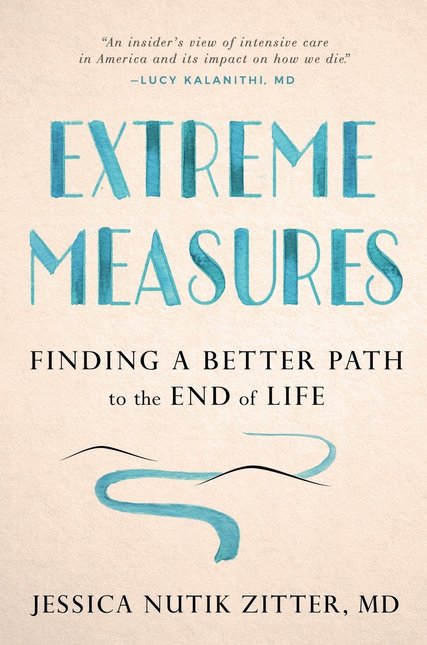
Other case histories in “Extreme Measures” are more troubling because their moral implications are less obvious. After a dramatic brain bleed from a major clot, a 45-year-old she calls George faces an operation that cannot return him to who he had been. His wife wants to know what Dr. Zitter would do if he were her husband. She explains that her husband would accept paralysis if he could remain communicative with her and their children at home.
Although Dr. Zitter fears that the surgeons who operated on George never broached the topic of his quality of life after surgery, she is heartened upon his return to the I.C.U.: He gives a thumbs-up. “What if, as a result of our talk, his wife had not consented to the surgery? Would I have been his unwitting killer?” This moment of self-doubt is followed by another turn of the screw. When Dr. Zitter later phones George’s wife, she says: “I am a single mother, but with another angry child.”
“Extreme Measures” includes a number of stories that explore the difficulties of talking about the subject of death with dysfunctional families, wracked by depression or feuds, and across racial, religious and ethnic divides. Often and to her credit, Dr. Zitter finds herself baffled, unsure of how to balance cultural priorities, human needs and medical possibilities. Throughout, she struggles personally and professionally to redefine common responses to terminal conditions.
In place of hope for recovery, Dr. Zitter emphasizes “the miracle of time at home, of pain management, of improved quality of life. These are all concepts I have seen families embrace in place of survival — the only concept of hope previously imagined.” And to people refusing “to play God” by withdrawing a breathing tube, she asks whether “they were playing God by keeping [a relative] alive when her body was actively dying.”
For readers who wish to avoid the end-of-life conveyor belt, Dr. Zitter concludes “Extreme Measures” with some practical advice on, for example, procuring a Physician Order for Life-Sustaining Treatment (POLST), a legal directive that emergency responders, paramedics and emergency room doctors are supposed to follow (but sometimes don’t, as Paula Span reported in The Times earlier this week).
Without this sort of documentation of end-of-life wishes, Dr. Zitter writes, a 90-year-old with metastasized prostate cancer ended up paralyzed and tethered to machines after cardiac arrests. “Our well-intentioned resuscitative efforts had crushed his cancer-weakened neck bones, rendering him quadriplegic.”
Passionately and poignantly, Dr. Zitter reminds us that “conveyor belts, regardless of their destination, are not meant for human beings.” Sometimes less is more.
Complete Article HERE!
Medical advancements have changed the way we die and view the process of death
The process of dying is a more complicated issue today because of advancements in life-sustaining technologies

By Yasmine Mian
[H]ow we die is a profoundly personal journey.
As college students, we don’t consider the topic of death frequently, let alone the process of dying. However, it is a universal theme that does not discriminate against anyone, no matter their age.
Throughout history, the process of dying is represented differently across cultures and religions. While some religions, like Buddhism and Hinduism believe it marks the beginning of rebirth or reincarnation after death, others, like Christianity, believe it marks the beginning of a journey to Heaven.
Regardless of the beliefs, to fully understand the process of dying and its aftermath, we must examine how the dying process has changed over time.
Throughout our history—particularly recently with medical advancements—the human race has looked far and wide to answer a complex question: What is a natural death? With so many life-sustaining technologies to potentially keep us alive indefinitely, many don’t know what a natural death entails anymore.
Universities like ASU offer courses exploring the cultural and religious aspects of death and dying.
While the biological process of dying is universal, the behaviors associated with expressing grief are very much culturally bound. Courses like these offered at universities allow students to learn how cultures have developed ways to cope with the process of dying.
Sally Johnson, a professor of psychology at Glendale Community College, believes that all students should study the cross cultural aspects of death.
“By learning about the way different cultures and religions treat the dying process, we can gain more insight into how they deal with the heartache and pain that comes along with death and how it manifests itself in the funeral/death process,” she said.
However, it is important to remember that the process of dying has drastically changed over the past several decades with the development of modern resuscitative technologies. It seems as if a “natural death” has no place in our society anymore.
The idea of a natural death is merely a reflection of the social and scientific context of the time that death took place in.
When we picture a natural death, we envision an individual lying in bed surrounded by loved ones, taking their last breaths in a place of comfort and homeliness, a sight of peace and tranquility often dreamed of in literature.
However, with the help of modern medicine and innovative technology, our perceptions of natural death have now changed.
Thanks to modern medicine, diseases like polio, scarlet fever and others have been rendered preventable, treatable, or far less common now. This has led to a dramatic extension of life.
However, these new technologies have also been used to prolong the life expectancy of individuals with terminal illnesses, such a cancer.
While the idea of prolonging life might sound like a good thing, it often forces patients, their loved ones and their doctors to make difficult, painful decisions.
In some cases, when patients have no hope of surviving, we use technology and drugs to simply keep them alive in a biological sense.
Families and doctors may feel as though they need to exhaust every available treatment or medication to prolong the dying process, however, that can be a naive and selfish outlook.
But what we don’t understand is that there is a difference between being alive and living. Medicine can’t cure everything, but we often act as though death is optional.
The dying process is usually centered around the elderly, who are approaching there last few months of life due to natural causes. When younger individuals do die, it’s usually the cause of an accident or life-threatening disease.
However, individuals of all ages, especially students should be aware of the cultural significance of death, especially as we begin to cope with the loss of loved ones or go into professions where death is common.
We must recognize the limits of our human knowledge and technology and accept the fact that eventually, all of us will die. As morbid as it sounds, it is a natural process of life and should not be pegged as a taboo topic.
Complete Article HERE!
Sharing One’s End of Life Choices – via a Mobile Device
By
[P]atients can now use their smartphones to share their wishes for end of life care — whether or not they want to be intubated or have CPR, for example — with ambulance crews, loved ones, emergency-room doctors and hospitals.
No more fumbling for a piece of paper, signed by the doctor, to show health-care providers when a terminally ill loved one is rushed to the hospital. Patients in New Jersey can have their wishes become part of their electronic medical record and shared on mobile devices.
The online version of the “Practitioner Orders for Life-Sustaining Treatment” was launched Friday, almost five years after New Jersey authorized the use of a paper form for frail and severely ill patients. The online version will be part of a registry maintained by the New Jersey Hospital Association, with strict safeguards for patient privacy.
“We’re moving beyond having a green paper hanging on the refrigerator,” said Health Commissioner Cathleen D. Bennett, speaking of the paper version of the POLST forms. When patients articulate their preferences, it helps them to live on their own terms at the end of life, she said.
They can also express their goals for care, ranging from a full attack on their disease to palliative or comfort care. The form is signed by both the patient and the doctor or advanced-practice nurse, and is considered a medical order. Emergency personnel can follow it whenever the patient can’t speak for himself.
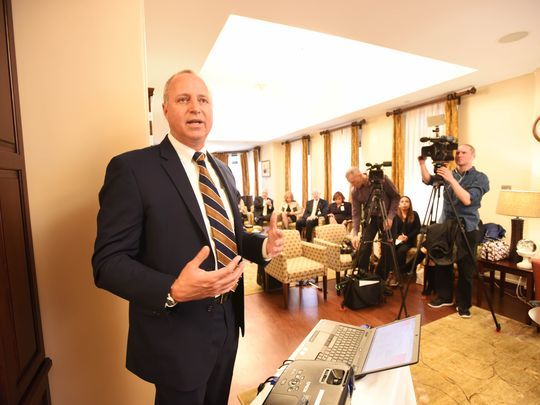
“Through this tool, more health-care providers will have immediate access to critical information they need to treat the patient according to the patient’s health-care preference,” Bennett said. “Patients with smart phones also will be able to share their electronic POLST form with a new physician, specialist or emergency-room doctor.”
In New Jersey, about 11,000 patients a year created POLST forms at each of the hospitals that participated in a study of it, said Joseph A. Carr, chief information officer for the New Jersey Hospital Association, who demonstrated the electronic version.
At a ceremony at the Villa Marie Claire Hospice in Saddle River, Bennett and Betsy Ryan, president of the association, signed an agreement for the association to become the online repository for the POLST forms. The villa, a former convent, is an inpatient hospice for 20 patients that is part of Holy Name Medical Center.
Talking about the end-of-life is one of the most important conversations a family can have, said Michael Maron, president of the medical center. The hospice’s decade of work has taught him that patients feel comforted and empowered when they are able to communicate their choices clearly and effectively, and they are understood by caregivers and loved ones.
The POLST form is available from the Department of Health or the New Jersey Hospital Association. For more information, also see National POLST Paradigm.
Complete Article HERE!
Five questions with end-of-life doctor
[A]merican palliative care doctor and end-of-life activist Bruce (B.J.) Miller was in Hamilton Thursday to talk about Life Before Death.
The free event was part of Hamilton Health Sciences’ new twice-a-year speakers’ series called GreatBigIdeas.
Miller has made it his life’s mission to improve end-of-life experiences for people and their families after an accident in his early 20s left him close to death and a triple amputee.
The Spectator spoke with Miller before his presentation.
Q — Why do you say you have a formal relationship with death?
A — I’ve come close enough to acknowledge it and by acknowledging death, it begins a relationship. You begin to relate to “nothing lasts forever”…I can comment on what it’s like to lose because of my own injuries…We can’t control everything — I chose to keep that in mind as I traverse the day. It helps me live more fully and appreciate what I have while I still have it…Loss is hard. It also proves how precious life is in the first place, which encourages us to enjoy it while we have it.
Q — Why does the health system not serve the dying very well?
A — By choosing to wage war on disease, we end up feeling like losers when we’re not curable and when we die. It’s a shaming…The system does incredible work on cures. But it abandons the people who are no longer fixable. This adds an extra layer of sadness that is unnecessary.
A — How can we make dying a better experience for all of us?
Acknowledging it and pulling it out of the closet …normalizing it, I think that would help…Stop dividing medical issues from social issues…I worry about all the wisdom that languishes in nursing homes. I worry that no one listens.
Q — You say you don’t have to be dying to benefit from palliative care. What do you mean?
A — Everyone conflates palliative care with end of life…Palliative care is about timing in the face of illness and quality of life. It includes end of life but is not focused on it. Hospice is devoted to the end…Palliative care is not running away from death but not focusing on it either.
Q — How can someone live well when facing imminent death?
Well, that process begins before (facing death). If you crafted a world view that includes death, you won’t be surprised when your time comes. That way your persona can remain intact and you can stay whole to the end…even as your body crumbles. If you see death as an unnecessary force, you’ll find yourself at odds with yourself.
Complete Article HERE!

